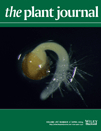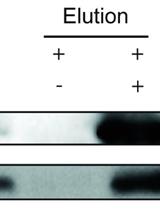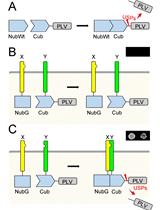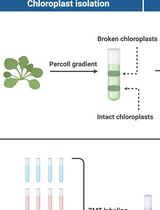- EN - English
- CN - 中文
CytoTrap Two-Hybrid Screening Assay
CytoTrap双杂交筛选系统
发布: 2014年12月05日第4卷第23期 DOI: 10.21769/BioProtoc.1310 浏览次数: 13708
评审: Tie LiuSaminathan Thangasamy
Abstract
CytoTrap two-hybrid system provides an alternate strategy to detect protein-protein interactions in yeast. In this system, bait protein is fused with human son of sevenless (hSos) protein (Li et al., 1993), and a cDNA library or prey protein is expressed by fusion with myristoylation signal which anchors the prey fusion protein to yeast cell membrane. Protein interaction between bait and prey proteins recruits the hSos protein to the cell membrane, where hSos activates the Ras signaling pathway, leading to the survival of temperature-sensitive Saccharomyces cerevisiae (S. cerevisiae) strain cdc25H at 36 °C. In the CytoTrap two-hybrid system, detection of protein interaction occurs in the cytoplasm near cell membrane and is not dependent on transcription activation of reporter genes. Hence, the system is particularly useful for identifying interaction partners of transcription factors and proteins that need post-translational modification in the cytoplasm, which could not be used as bait proteins in conventional transactivation-based yeast two-hybrid systems. Here we describe the construction of a cDNA library from the model plant Arabidopsis and a procedure for screening interaction proteins of AtSR1/CAMTA3, a Ca2+/CaM-regulated transcription factor from this library. This procedure could be adapted to identify interacting partners of interested proteins from other organisms.
Keywords: Cytotrap system (CytoTrap系统)Materials and Reagents
- XL10-Gold Kanr Ultracompetent cells (Agilent, catalog number: 200317 )
- RNeasy plant mini kit (QIAGEN, catalog number: 74904 )
- Oligotex mRNA mini kit (QIAGEN, catalog number: 70022 )
- CytoTrap two-hybrid system (Agilent, catalog number: 200444 )
- YeastmakerTM yeast transformation system 2 (Takara Bio Company, Clontech, catalog number: 630439 )
- AccuScript (Agilent, catalog number: 200820 )
- RNase H (New England Biolabs, catalog number: M0297S )
- DNA polymerase I (New England Biolabs, catalog number: M0209S )
- UltraPureTM phenol: chloroform: isoamyl alcohol (25:24:1, v/v) (Life Technologies, catalog number: 15593-031 )
- T4 ligase (New England Biolabs, catalog number: M0202S )
- T4 polynucleotide kinase (New England Biolabs, catalog number: M0201S )
- Xho I (New England Biolabs, catalog number: R0146M )
- Acid-washed glass beads (Sigma-Aldrich, catalog number: G8772 )
- TritonTM X-100 (Thermo Fisher Scientific, catalog number: BP151-100 )
- Sodium dodecyl sulfate (SDS) (Thermo Fisher Scientific, catalog number: BP166-100 )
- Sodium chloride (NaCl) (J.T.Baker®, catalog nuber: JT3628-1 )
- Tris (J.T.Baker®, catalog number: JT4109-1 )
- EDTA (J.T.Baker®, catalog number: JT8993-1 )
- Yeast extract (Thermo Fisher Scientific, catalog number: BP9727-500 )
- Peptone (Thermo Fisher Scientific, catalog number: BP9725-500 )
- Dextrose (J.T.Baker®, catalog number: JT1919-1 )
- Adenine sulfate (Sigma-Aldrich, catalog number: A2545 )
- Yeast nitrogen base without amino acids (BD, catalog number: 291940 )
- DO supplement -His/-Leu/-Trp/-Ura (Takara Bio Company, Clontech, catalog number: 630425 )
- Histidine (Sigma-Aldrich, catalog number: H6034 )
- Tryptophan (Sigma-Aldrich, catalog number: T0254 )
- Galactose (Sigma-Aldrich, catalog number: G0750 )
- Raffinose (Sigma-Aldrich, catalog number: R0250 )
- Yeast lysis solution (see Recipes)
- YPDA/YPAD (see Recipes)
- SC/-LU (glucose) (see Recipes)
- SC/-LU (galactose) (see Recipes)
- 10x STE buffer (see Recipes)
Equipment
- Replica plating mold (Sunrise Science Products, catalog number: 3005-002 )
- RNase-free microcentrifuge tube (BioExpress, catalog numer: C-3262-2 )
- Microcentrifuge (Eppendorf, catalog number: 5424 )
- Shaker (New Brunswick Scientific, catalog number: M1299-0092 )
- Incubator (VWR International, catalog number: 414005-128 )
- 150-mm plate (VWR International, catalog number: 25384-326 )
- PCR thermocycler (Eppendorf, catalog number: 6321 000.515 )
Procedure
文章信息
版权信息
© 2014 The Authors; exclusive licensee Bio-protocol LLC.
如何引用
Zhang, L., Du, L. and Poovaiah, B. W. (2014). CytoTrap Two-Hybrid Screening Assay. Bio-protocol 4(23): e1310. DOI: 10.21769/BioProtoc.1310.
分类
植物科学 > 植物生物化学 > 蛋白质 > 相互作用
微生物学 > 微生物遗传学 > DNA > DNA 相互作用
分子生物学 > 蛋白质 > 蛋白质-蛋白质相互作用
您对这篇实验方法有问题吗?
在此处发布您的问题,我们将邀请本文作者来回答。同时,我们会将您的问题发布到Bio-protocol Exchange,以便寻求社区成员的帮助。
Share
Bluesky
X
Copy link













